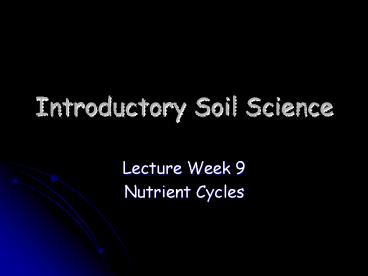Introductory Soil Science - PowerPoint PPT Presentation
1 / 22
Title:
Introductory Soil Science
Description:
boron (B), copper (Cu), iron (Fe), chloride (Cl), manganese ... example of lime-induced chlorosis' difficult/expensive to correct - add S. Low pH: more serious ... – PowerPoint PPT presentation
Number of Views:51
Avg rating:3.0/5.0
Title: Introductory Soil Science
1
Introductory Soil Science
- Lecture Week 9
- Nutrient Cycles
2
Mineral Nutrients
- Macro nutrients (used in large quantities)
- Primary
- Nitrogen (N), phosphorus (P) potassium (K)
- Secondary Minerals
- Calcium (Ca), Magnesium (Mg), Sulfur (S)
- Micronutrients (used in small quantities)
- boron (B), copper (Cu), iron (Fe), chloride (Cl),
manganese (Mn), molybdenum (Mo) and zinc (Zn).
3
Importance of Nutrients in Natural Systems
- Nutrient cycling is an important ecosystem
process. - Land degradation may adversely affect cycles -
restoration may have to address this. - Nutrient status influences the type of plant
community
4
(No Transcript)
5
The Nitrogen Cycle
- A distinctive cycle because N does not occur in
minerals. - One of the most important ( often limiting) for
plant growth. - The cycle can be considered in four parts
- ammonification,
- nitrification,
- nitrogen fixation,
- denitrification.
6
The Nitrogen Cycle (cont.)
7
Phosphorus
- Phosphorus is an essential nutrient for plants
and animals in the form of ions PO43- and HPO42- - part of DNA-molecules, molecules that store
energy (ATP and ADP) and fats of cell membranes - building block of certain parts of the human and
animal body, such as the bones and teeth
8
Phosphorus
- found in water, soil and sediments
- moves slowly from deposits on land and in
sediments, to living organisms, and then much
more slowly back into the soil and water sediment - phosphorus cycle is the slowest of the matter
cycles
9
Phosphorus
- commonly found in rock formations and ocean
sediments as phosphate salts - released from rocks by weathering
- dissolve in soil water and absorbed by plants
- Because the quantities of phosphorus in soil are
generally small, it is often the limiting factor
for plant growth - so humans often apply phosphate fertilizers on
farmland. - Animals absorb phosphates by eating plants or
plant-eating animals
10
Phosphorus Cycle
- Phosphorus cycles through plants and animals much
faster than it does through rocks and sediments. - When animals and plants die, phosphates will
return to the soils or oceans again during decay.
- P ends up in sediments or rock formations again,
remaining there for millions of years. - released again by weathering and the cycle starts
over
11
(No Transcript)
12
Phosphorus Cycle
13
Potassium
- The third macronutrient
14
Potassium
- potassium is much different to N P.
- forms ionic bonds with many different anions
- important as an enzyme activator in plants
- involved in facilitating membrane permeability
and translocation of sugars - essential for photosynthesis, fruit formation,
winter hardiness, disease resistance and amino
acid and protein formation
15
The Potassium Cycle
Component
Input to soil
Loss from soil
Animal manures and biosolids
Crop harvest
Plant residues
Mineral fertilizers
Runoff and erosion
Exchangeable potassium
Plant uptake
Soil solution potassium (K)
Fixed potassium
Mineral potassium
Leaching
16
Potassium
- Generally greater than 90 of the potassium in
soils is unavailable - 1-10 is slowly available K trapped in clays or
non-exchangeable K - only 0.1-2 of soil K is readily available in
soil solution. - Soil clays hold potassium on surfaces - called
exchangeable K - plants readily take up this form
- Clays such as illite and vermiculite can trap or
fix K between particles - this is then slowly released
- potassium can be found in minerals in the soil or
make up part of the clay particles - This form is almost completely unavailable and
will only be available with extreme amounts of
weathering and long periods of time
17
Nutrient Status of Aust. Soils
- old age and poverty
- Salinity (see OH)
- Paradox of high species richness on very
infertile soils.
18
pH and Nutrient Availability
- Soil pH usually falls in the range 4 - 10.
- pH has marked effects on the chemical form in
which nutrients occur. - Nutrient availability can therefore be altered
(see figure).
19
(No Transcript)
20
Example - P availability
- pH lt 6.5 Al, Fe /or Ca insoluble phosphates
begin to form - 6.6 - 7.5 H2PO4- ions - soluble
- 7.5 - 8.5 Ca insoluble phosphate
- gt 8.5 HPO4-- ions - soluble
21
Consequences of High/low pH
- High pH
- a number of micronutrients less available
- example of lime-induced chlorosis
- difficult/expensive to correct - add S
- Low pH
- more serious
- more nutrients are less available
- greater availability of Mn Al - toxicity
- bacterial activity declines
- easier to correct by liming (CaCO3)
22
Major Ideas
- Most essential nutrients derive from weathering
of parent material. - Nutrient cycling is a fundamental ecosystem
process. - Most nutrients are held in reserves that are not
immediately available. - N is not derived from parent material - has an
atypical cycle. - Aust. soils have poor nutrient status -
evolutionary adaptations of our plants (include.
mutualistic relationships). - pH has considerable influence on nutrient
availability.































